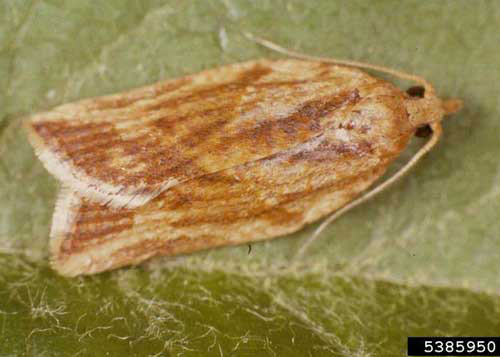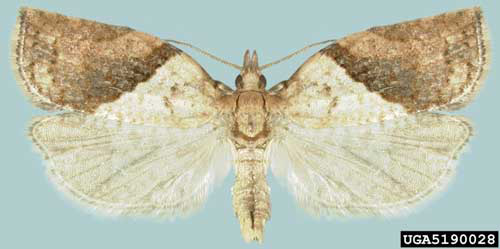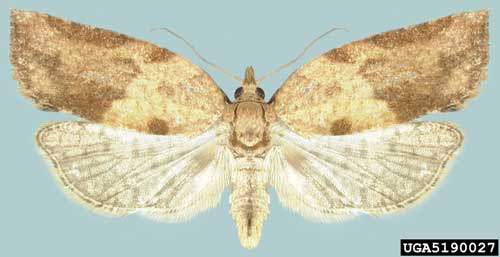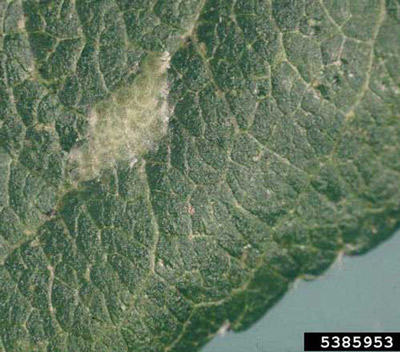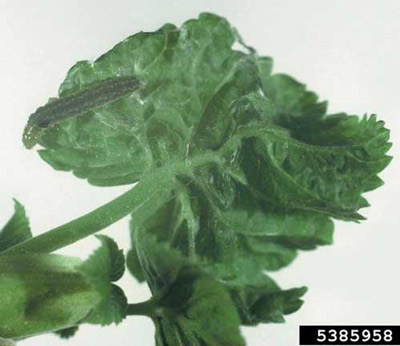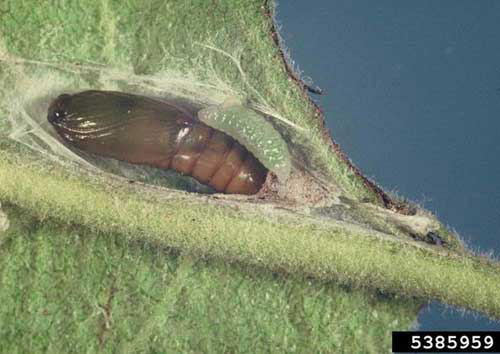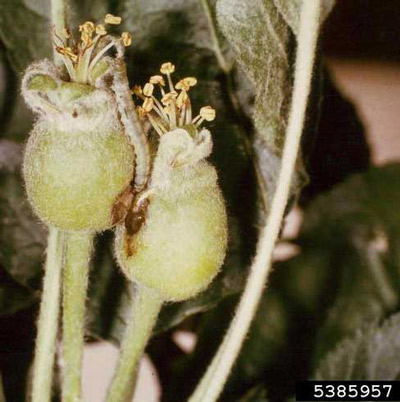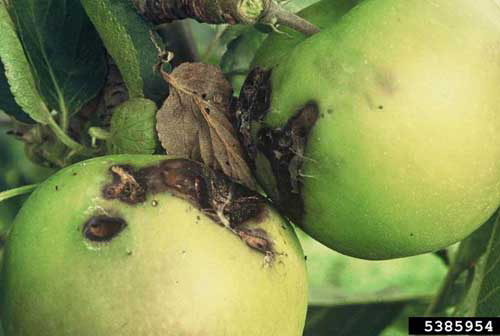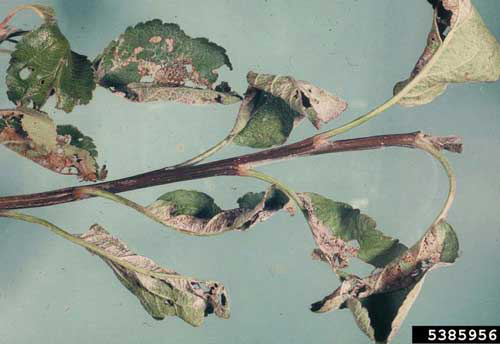common name: light brown apple moth
scientific name: Epiphyas postvittana (Walker) (Insecta: Lepidoptera: Tortricidae)
Introduction - Distribution - Description and Life Cycle - Hosts - Damage - Economic Importance - Management - Selected References
Introduction (Back to Top)
The light brown apple moth, Epiphyas postvittana (Walker), is an extremely polyphagous insect and considered to be a major pest of fruits (i.e., pome fruits such as apples) and ornamental plants (Danthanarayana 1975). Although light brown apple moth currently has a limited and regulated distribution in the U.S., it has the potential to threaten ecological and agricultural systems. Specifically, the worldwide distribution of light brown apple moth across dry, temperate, and tropical climates as well as a variety of geographic ranges suggests that the pest may be able to inhabit almost 80% of the continental U.S. (Venette et al. 2003). Recent findings of the pest in California, where it has no natural predators, demonstrate its ability to infest four main U.S. crops: apples, grapes, oranges and pears.
Figure 1. Dorsal view of adult light brown apple moth, Epiphyas postvittana (Walker). Photograph by Department of Primary Industries and Water, Tasmania Archive; Bugwood.org.
Distribution (Back to Top)
Light brown apple moth is a pest native to Australia and believed to infest acacias and other evergreens. It spread to New Zealand, England, Ireland, and Hawaii through various commercial agricultural shipments during the 1800s-1900s (Danthanarayana 1975).
Over the past few decades in the United States, light brown apple moths have occasionally been intercepted in Honolulu, Los Angeles, and San Francisco in infested material, primarily caught on international strawberry shipments (Venette et al. 2003). In March of 2007, USDA representatives confirmed the presence of the pest in Alameda County, California, and the California Department of Food and Agriculture (CDFA) subsequently discovered the pest in an additional eleven counties (USDA-APHIS-PPQ 2009). The detection of light brown apple moth in the continental U.S. led to immediate quarantine and eradication program. If light brown apple moth is not properly contained, not only fruit and agronomic crops, but urban and natural trees, such as redwoods, oaks, and cypress may be at risk (USDA-APHIS-PPQ 2009). Eradication has been successful in some counties, but others are still implementing eradication programs (NAPIS 2009).
A full tracking map generated from Cooperative Agricultural Pest Survey Programs (CAPS) is available at http://pest.ceris.purdue.edu/searchmap.php?selectName=ITBUBPA.
Description and Life Cycle< (Back to Top)
Initial identification of light brown apple moths requires expert species-level confirmation as light brown apple moths may exhibit color variations and be difficult to distinguish from other brown moths. The LBAM ID: Tools for diagnosing the light brown apple moth and related western U.S. leafrollers (Tortricidae: Archipini) is available at http://keys.lucidcentral.org/keys/v3/LBAM/lucid.html.
Adults: The adult light brown apple moths, when resting with wings folded, are approximately 0.4 inches (10 mm) long. The moths are typically yellow-brown in color and have dark markings on the forewings (USDA-APHIS-PPQ 2008a). Light brown apple moths are sexually dimorphic, and the females are differentiated by a dark mark located on the hind margin of each forewing (Danthanarayana 1975). Adults are nocturnal, and females attract males with a sex pheromone. Most light brown apple moths will not fly further than 328 feet (100 meters), but some may fly up 1969 feet (600 meters) for mating (Espinosa and Hodges 2009).
Figure 2. Dorsal view of an adult male light brown apple moth, Epiphyas postvittana (Walker). Photograph by Natasha Wright, Florida Department of Agriculture and Consumer Services; Bugwood.org.
Figure 3. Dorsal view of an adult female light brown apple moth, Epiphyas postvittana (Walker). Photograph by Natasha Wright, Florida Department of Agriculture and Consumer Services; Bugwood.org.
Eggs: Female light brown apple moths can mate and lay eggs six to 10 days after emerging from the pupa. Masses of two to 170 eggs are laid on the smooth leaf surfaces of host plants and appear flat (with a pebble-like surface) (Espinosa and Hodges 2009). Eggs, which are usually around 0.04 inches (between 0.84 and 0.95 mm) long, will hatch after five to 30 days, dependent upon the temperature of the area (USDA 2008). Mature females can produces between 300 and 1,500 eggs (USDA-APHIS-PPQ 2008b).
Figure 4. Egg mass of the light brown apple moth, Epiphyas postvittana (Walker). Photograph by Department of Primary Industries and Water, Tasmania Archive; Bugwood.org.
Larvae: Light brown apple moth larvae have six developmental instars, and reach of size of 0.4-0.7 inches (10-18) mm long prior to (Danthanarayana 1975). Larvae hatch on the surfaces of leaves, emerging as small, pale, yellow-green caterpillars with light brown heads. Young larvae migrate across the surfaces of their hosts, sometimes suspending themselves from silk threads to find additional sites for feeding. Early-instar larvae often spin a finely-webbed protective cover for feeding, or a leaf roll, on the underside of nearby leaves (USDA-APHIS-PPQ 2008a). Larvae may also migrate to the flowers and fruits for feeding, leaving brown pits and scars (USDA-APHIS-PPQ 1984).
Figure 5. Late instar larva of the light brown apple moth, Epiphyas postvittana (Walker), feeding on leaf. Photograph by Department of Primary Industries and Water, Tasmania Archive; Bugwood.org.
Pupae: When first spun, the pupae appear to be green but quickly harden to produce a brown chrysalis. The casing, which is typically 0.4-0.6 inches (10-15 mm) long, is often found within a "leaf roll," or a silken cocoon spun and woven between two leaves. The female pupae are typically larger than male pupae, but the two can be distinguished through markings/characteristics on the lower surface of the chrysalis (Danthanarayana 1975).
Figure 6. Pupa (left) and early instar larva (right) of the light brown apple moth, Epiphyas postvittana (Walker). Photograph by Department of Primary Industries and Water, Tasmania Archive; Bugwood.org.
The life cycle of light brown apple moth, from egg to larva to pupa to adult, is longer during cooler temperatures (Danthanarayana 1975). In warmer climates, four to five overlapping generations may occur. Only two generations typically occur in cooler climates. Overwintering typically occurs between the 2nd and 4th larval instar. (Espinosa and Hodges 2009).
Hosts (Back to Top)
Light brown apple moths feed on more than 120 genera of plants and thousands of species throughout the world (Venette et al. 2003, Espinosa and Hodges 2009). Some of the more economically important crops include:
Fruit Crops:
- Actinidaceae: Actinidia sp. - kiwifruit
- Anacardiaceae: Mangifera indica - mango
- Ebenaceae: Diospyros sp. - persimmon
- Ericaceae: Vaccinium sp. - blueberries
- Lauraceae: Persea americana - avocado
- Musaceae: Musa paradisiaca - plantain
- Rosaceae:
- Fragaria sp. - strawberries
- Malus domestica - apples
- Prunus spp. - apricot, plum, peach
- Pyrus sp. - pear
- Rubus sp. - raspberry
- Rutaceae: Citrus spp. - citrus
- Vitaceae: Vitis sp. - grapes
Vegetables
- Brassicaceae: Brassica sp. - cabbage, broccoli, cauliflower
- Poaceae: Zea mays - corn
- Solanaceae:
- Capsicum sp. - peppers
- Solanum lycopersicum - tomatoes
Ornamentals and Trees
- Adoxaceae: Viburnum sp.
- Apocynaceae: Vinca sp.
- Araliaceae: Hedera sp. - ivy
- Asteraceae:
- Chrysanthemum sp. - mums
- Dahlia sp.
- Gerbera sp.
- Betulaceae: Alnus sp. - alder
- Fagaceae: Quercus sp. - oak
- Juglandaceae: Juglans sp. - walnut
- Lamiaceae: Salvia sp.
- Oleaceae: Jasminum sp. - jasmine
- Rosaceae: Rosa sp. - roses
- Salicaceae:
- Salix sp. - willows
- Populus sp.- poplars, cottonwood
- Theaceae: Camellia sp.
Damage (Back to Top)
The larvae construct "leaf rolls", or nests, which damage the leaves, surfaces of the fruits, and sometimes tunnel into the flesh of the fruit itself (Danthanarayana 1975). The immatures feed on and damage seedlings, ornamental plants, deciduous fruit-tree crops, and fruits such as grapes and citrus (Geier and Briese 1981). By feeding on the buds and leaves, the caterpillars reduce the rate of photosynthesis, disfigure the host plant, reduce growth rate, and leave the fruit unmarketable (Irvin 2009). Infestations in grapevines can cost thousands of dollars per hectare if left unchecked. The larvae can destroy the leaves of the vines as well as mature grapes and lead to opportunistic growth and damage caused by Botrytis cinerea grey mold (Bailey et al. 1996, Nair 1985).
Figure 7. Larvae of the light brown apple moth, Epiphyas postvittana (Walker), feeding on apple buds. Photograph by Department of Primary Industries and Water, Tasmania Archive; Bugwood.org.
Figure 8. Light brown apple moth, Epiphyas postvittana (Walker), larval feeding damage to apple buds. Photograph by Department of Primary Industries and Water, Tasmania Archive; Bugwood.org.
Figure 9. Damage to apples, Malus domestica Borkh., caused by the light brown apple moth, Epiphyas postvittana (Walker). Photograph by Department of Primary Industries and Water, Tasmania Archive; Bugwood.org.
Figure 10. Light brown apple moth, Epiphyas postvittana (Walker), feeding damage to apple leaves. Photograph by Department of Primary Industries and Water, Tasmania Archive; Bugwood.org.
Economic Importance (Back to Top)
A USDA quantitative analysis estimated that light brown apple moths could cause upwards of $118 million in damages in high-risk areas, affecting not only the apple, grape, orange and pear crops of the country, but also to nursery stock due to widespread international and domestic trade restrictions (USDA-APHIS-PPQ 2009). This same analysis predicted that the West Coast, southwestern and southeastern states were at the highest risk for agricultural impact, suggesting that 58% of the apple crop, 97% of the grape crop, 100% of oranges, and 73% of pears are at risk for infestation. From these estimates, it is anticipated that economic loss for oranges would reach 43%, grapes: 30%, apples: 22%, and pears: 5%. Because the pests can produce four or five generations in one season in California, a single outbreak is projected to increase dramatically if left unchecked. Currently, incalculable damage to trade and export markets has already occurred. Several importing countries, including Canada, Chile and Mexico, have enacted restrictions on crops from infested counties.
Millions of dollars have already been used to prevent the spread of the pest. The USDA already allocated $15 million to use for eradication of the pest from California in 2007 and another $74.5 million for 2008 (Irvin 2009), and the program is anticipated to continue until 2015. Ken Corbishley, the Santa Cruz County agriculture commissioner, estimated that costs for farmers can reach between $500 and $800 an acre for chemical treatment (Jones 2009).
Management (Back to Top)
The light brown apple moth eradication program, 2008-2015, involves the following steps:
- screening for rapid detection of populations,
- containment,
- suppression,
- eradication with sterile male light brown apple moths.
- (CDFA 2009)
Rapid response and research methods to increase success are integrated into programmatic efforts.
The following chief strategies are emphasized by the program:
- continuing the rigorous moth trapping and detection program throughout the state of California and other at risk states, including the southeastern U.S.,
- releasing sterile male light brown apple moths through the use of the sterile insect technique (SIT)
- applying ground-based treatments to control remote infestations,
- immediately suppressing "leading edges" of infestations by employing ground-based treatments,
- utilization of these treatments in densely-affected areas (i.e. commercial nurseries) to reduce artificial/mechanical spread,
- rigorous enforcement of quarantines, and
- use of aerial treatments in unoccupied areas only when necessary.
Some alternative methods that have also been proposed include the use of pheromone traps and biological controls, such as the Trichogramma platerni and Trichogramma pretiosa wasps.
It is believed that an overuse of pesticides had led to some chemical resistance in the pest, and widespread objection to use of pesticide sprays occurred in California. Research on control of the pest on apple crops has shown that as the larvae mature, they become incredibly difficult to control (Lay-Yee et. al. 1997).
Contact information for the light brown apple moth CDFA Project (including alleged detection of the insect in an area) is available at http://www.cdfa.ca.gov/phpps/PDEP/lbam/contacts.html.
As light brown apple moth is considered a non-established pest under quarantine and eradication in the U.S., local cooperative extension management recommendations are not available. If light brown apple moths were to become established in the continental U.S., then state-specific management information would become available.
Selected References (Back to Top)
- Bailey P, Baker G, Caon G. 1996. Field efficacy and persistence of Bacillus thuringiensis var. kurstaki against Epiphyas postvittana (Walker) (Lepidoptera: CAPS PRA: Epiphyas postvittana 7 Tortricidae) in relation to larval behaviour on grapevine leaves. Australian Journal of Entomology 35: 297-302.
- CDFA. (2008). The Light Brown Apple Moth Program: 2008 Report to the Legislature. California Department of Food and Agriculture. (23 April 2013).
- CDFA. (2009). Light Brown Apple Moth Eradication Program: (Draft) Programmatic Environmental Impact Report. California Department of Food and Agriculture. (23 April 2013).
- Danthanarayana W. 1975. The Bionomics, distribution and host range of the light brown apple moth, Epiphyas Postvittana (Walk.) (Tortricidae). Australian Journal of Zoology 23: 419-437.
- Espinosa A, Hodges AC. (2009). Epiphyas postvittana. Bugwood Wiki. (5 January 2010).
- Geier P, Briese D. 1981. The light-brown apple moth, Epiphyas postvittana (Walker): a native leafroller fostered by European settlement. pp. 131-155. In Kitching R, Jones R [eds.], The Ecology of Pests. CSIRO, Melbourne, Australia.
- Irvin N. (2009). Light Brown Apple Moth. Center for Invasive Species Research. (5 January 2010).
- Jones D. (2009). Vigilance urged after moth find. San Jose Mercury News - Central Coast. (23 April 2013).
- Lay-Yee M, Whiting DC, Rose KJ. 1997. Response of 'Royal Gala' and 'Granny Smith' apples to high-temperature controlled atmosphere treatments for control of Epiphyas postvittana and Nysius huttoni. Postharvest Biology and Technology 12: 127-136.
- Nair NG. 1985. Fungi associated with bunch rot of grapes in the Hunter Valley. Australian Journal of Agricultural Research 36: 435-442.
- NAPIS. (2009). Reported Status of Light Brown Apple Moth, Epiphyas postvittana. Pest Tracker. (23 April 2013).
- USDA-APHIS-PPQ. 1984. Pests not known to occur in the United States or of limited distribution No. 50: Light-brown apple moth. pp. 1-12. APHIS-PPQ, Hyattsville, MD.
- USDA-APHIS-PPQ. (2008a). Light Brown Apple Moth. Animal and Plant Health Inspection Service. (23 April 2013).
- USDA-APHIS-PPQ. (2008b). Questions and Answers: Light Brown Apple Moth. Animal and Plant Health Inspection Service. (no longer available online).
- USDA-APHIS-PPQ. (2009). Economic Analysis: Risk to U.S. Apple, Grape, Orange and Pear Production from the Light Brown Apple Moth, Epiphyas postvittana (Walker). Animal and Plant Health Inspection Service.(23 April 2013).
- Venette RC, Davis EE, DaCosta M, Heisler H, Larson M. 2003. Mini Risk Assessment: Light brown apple moth, Epiphya postvittana (Walker) [Lepidoptera: Tortricidae]. Department of Entomology, University of Minnesota.
